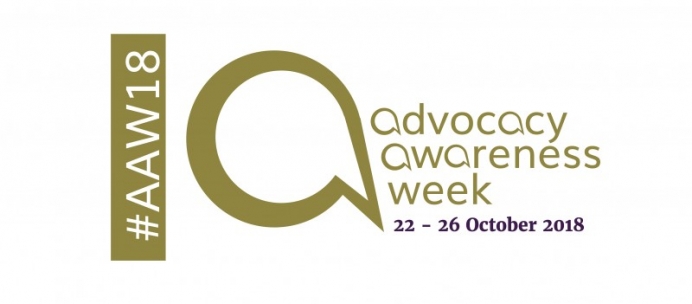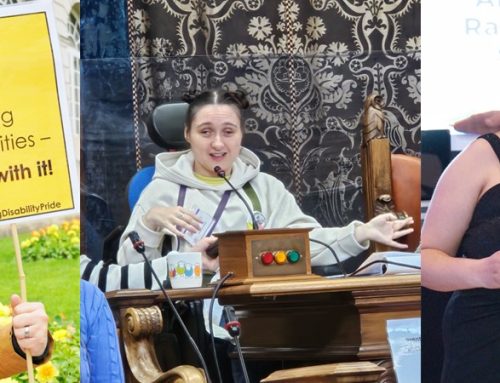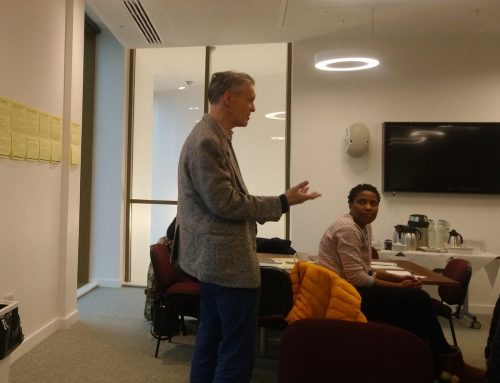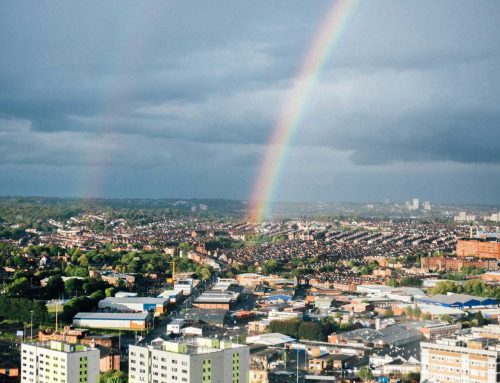By Gill Loomes, Leeds Autism AIM Peer Development Worker
Welcome to the final part of our mini-series for Advocacy Awareness Week 2018, called “Finding our Voice”, where we are thinking about the importance of “Voice” in advocacy, and in how we raise awareness of advocacy work. So far in the series, we have thought about “Voice” as a bridge between the individual and the world around them.
In the previous part (Part 3), we considered the first two of five themes that form the concept of “Voice” (identity-building, and self-expression). In this final part, we think about the final three themes that focus on the social world, and how, as individuals, we can shape and change the world around us.
Social Participation
While the previous two aspects of “voice” that I’ve considered have been concerned very much with the individual, and the “self”, it is also clear that our “voice” is what connects us with, and enables us to engage with the social world around us. Indeed much research looks at the ways in which the “voices” of individuals and groups can shape the community of which they are a part.
Examples include the organization of user panels by Age Concern in Fife, Scotland, to enable older people who use social care services to have a say in how those services work (Barnes and Bennett, 1998); and the role of the parents of children with social communication needs in influencing how special education provisions operate (Burke et al., 2018).
For advocates, supporting our advocacy partners in social participation will probably feel like a familiar, fundamental aim. This aspect of our work will require that we focus both on the individual we are supporting, in terms of creating and facilitating opportunities for social participation through the organization of self-advocacy and other representation groups, but also concentrating our attention on institutions and organizations in the world around us, to scrutinize the extent to which they facilitate the participation of our advocacy partners, and to challenge inaccessible and exclusionary structures and practices.
There is a great discussion about this, in the context of supporting people with learning disabilities, who live in residential care, to vote, by Elaine James (2016), which can be found in the York Policy Review.
Advocacy
Here we reach our special interest.
Advocacy, in its narrow sense, involves “a process of supporting and enabling people to:
- Express their views and concerns.
- Access information and services.
- Defend and promote their rights and responsibilities.
- Explore choices and options” (seAp, 2018)
In respect of its relationship to the overall concept of “voice”, it is important to recognise that advocacy has one key difference from the aspects of “voice” that I’ve already discussed: i.e. it can be done by a person on behalf of someone else. So, while some of the work we do can involve empowering people through self-advocacy, much of it is concerned with representing the views and wishes of our advocacy partners, with varying degrees of involvement by the partner themselves.
This can be uncomfortable territory. I would suggest that a reason for this discomfort is found in the elements of “voice” I have discussed above. In particular, given that a person’s “voice” is associated in part with their identity, and their self-expression, it can be very challenging to perform these aspects of “voice” on behalf of someone else.
I suggest that the model of “voice” that I am setting out can provide a useful format to begin to interrogate this discomfort in speaking on behalf of someone else. In separating out these strands of “voice” we can begin to think clearly about the work that we are doing on behalf of our advocacy partners. We can see where we can clearly and comfortably work on their behalf – e.g. through facilitating their social participation, and enforcing their rights, while identifying the borders where the “voice” becomes concerned with identity, and the “self” – looking at what we know about the person’s own identity (the “voices” that were/are important to them, and how they express their identity through their own “voice”), and articulating this on their behalf, where appropriate.
Social Disruption
Social disruption also belongs in the family of advocacy-related practices that form part of the ways in which individuals can make their mark on the social world through “voice”. Specifically, it is where we use our “voice” in the pursuit of social change. In this sense, it is advocacy, but it is radical advocacy that seeks to challenge (to disrupt) the social order, to go beyond the securing of rights already granted through existing laws and social norms, in order to break new ground, and forge new rights.
Examples of this include the ways in which campaigning groups engage in direct action in order to protest against injustice and discrimination. Disabled People Against Cuts (DPAC) are one particular group that engages in such direct action in order to raise awareness of the impact on disabled people of cuts to benefits and social care funding. An example of their direct action includes members trespassing in wheelchairs onto tramlines in Manchester as part of protests at the Tory party conference in 2017.
The right to this form of “voice” can be compromised for people with disabilities. This can be because of social and cultural attitudes to disability that mean that adults with disabilities are treated in risk-averse ways, and denied opportunities to be subversive, or to transgress existing social norms; or it can arise through socio-legal practices (e.g. those associated with the Mental Health Act, 1983/2007; or the Mental Capacity Act 2005). It is perhaps in these situations where the role of the advocate is most crucial.
There are often significant barriers that can deter advocates and advocacy organizations from pursuing the rights of individuals to a socially disruptive “voice” (e.g. concerns about reputation management, and impact on funding). However, it is also in these circumstances where it becomes most important to acknowledge that as advocates, we stand alongside our advocacy partners, and should prioritize their rights and interests.
In pursuing a socially disruptive “voice”, we can stand on the shoulders of giants, who have fought for, and won significant social and cultural shifts for marginalized individuals, and minority groups. It is brave work, where we use our “voice” to build new bridges with the social world. The stakes are high, as we run the risk of ending up with a pile of rubble. But when we win, we create a sea-change, not just for ourselves and our advocacy partners, but for the world beyond.
In this mini-series, we’ve explored the theme of “Voice” that is so often at the heart of how we describe advocacy, and discuss the work we do. We have suggested that when we talk about “voice”, we are often referring to “a bridge between ourselves and the world around us”. And we have discussed five key themes that make up this bridge: Identity-building; self-expression; social participation; advocacy; and social disruption.
We have also considered what each of these themes may mean in the context of advocacy practice, and how we describe what we do. We hope that the ideas we have presented here can give food for thought, and sow the seeds of reflection and discussion during this Advocacy Awareness Week, and beyond.[/vc_column_text][vc_empty_space][vc_separator color=”black” border_width=”5″][vc_empty_space][vc_column_text]












